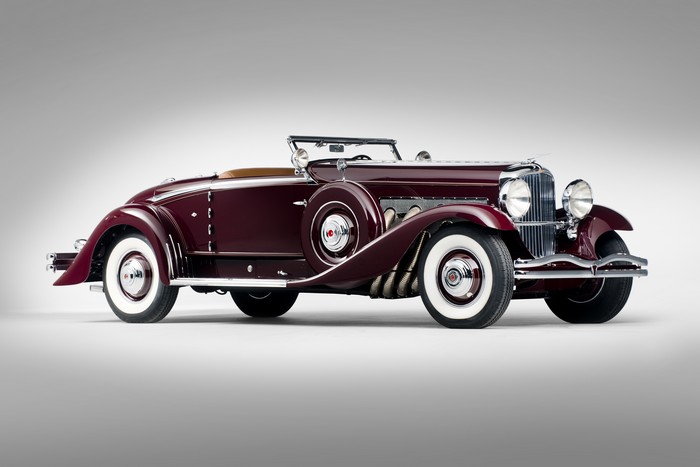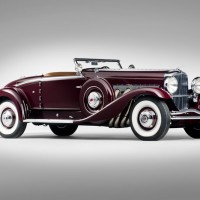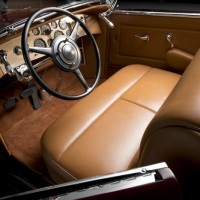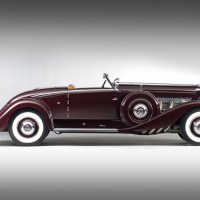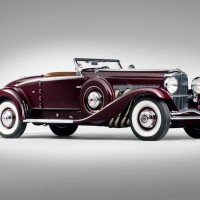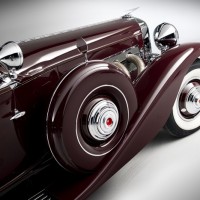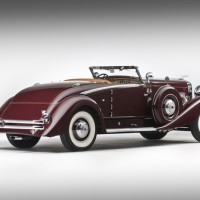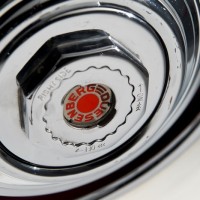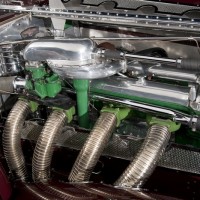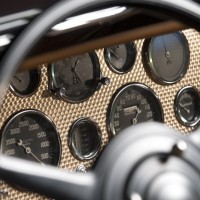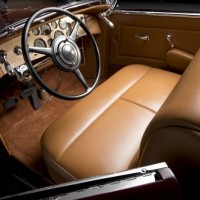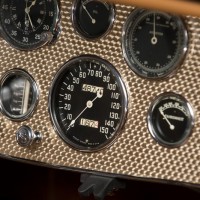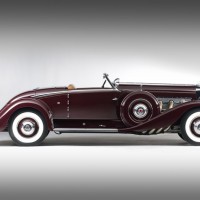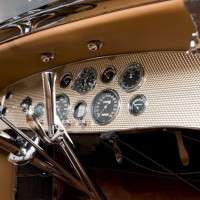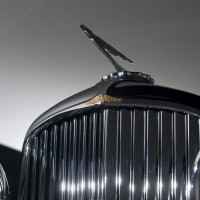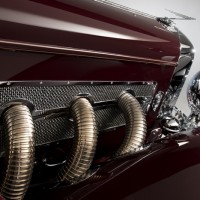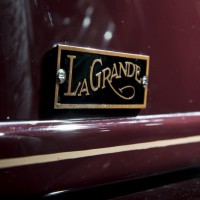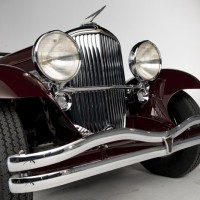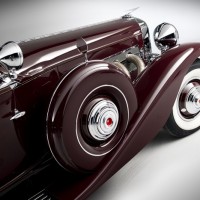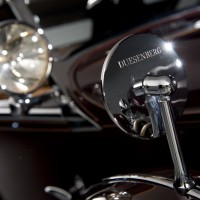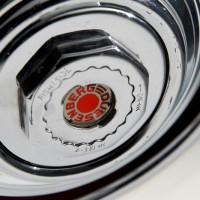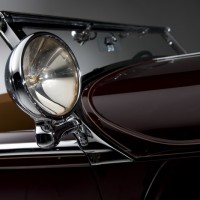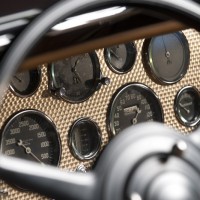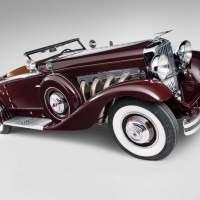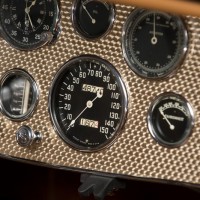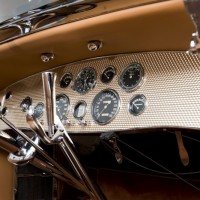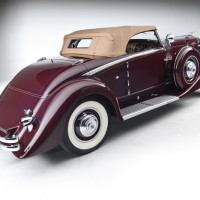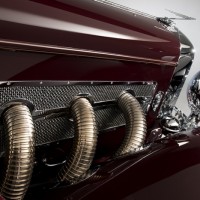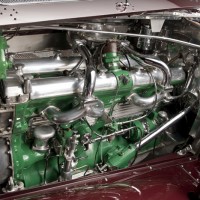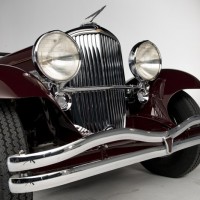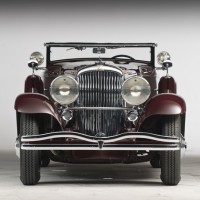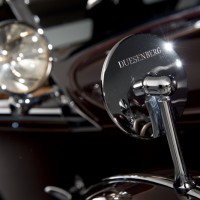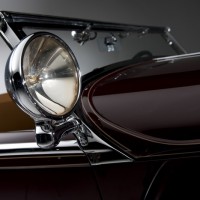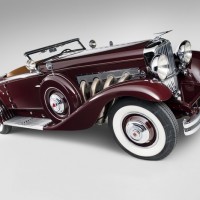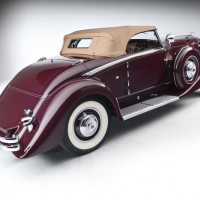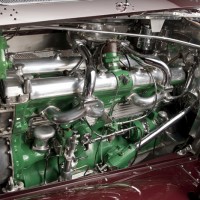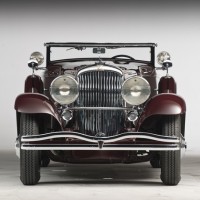As advanced as the Model J Duesenberg was upon its introduction in 1929, most of the technical advancements contained within were confined to the body and chassis. The design of the front end and fenders — as well as that of most coachbuilt bodies — still bowed toward late-1920s convention, albeit stylishly. As a result, by the mid-1930s, the Duesenberg still held mechanical prowess over virtually everything else on the road. From a design standpoint, however, it was looking rather dated.
J. Herbert Newport, who had succeeded Gordon Buehrig as Duesenberg’s body designer, set out to do something about that. Among his creations for the Model J was a new convertible coupe, which incorporated the best of the Duesenberg’s trademark styling cues with the curves of modern streamlining. The traditional upright radiator shell and headlights were now accompanied by deeply skirted and rounded fenders, designed by Alex Tremulis and added at the factory branch, over 17-inch wheels. The beltline began as a slender molding running alongside the hood, and as it reached the windshield, it expanded out along the sides of the body into a polished “sweep,” which then fell back along the long fender like a trailing comet.
Production of this body style was handled by the A.H. Walker Body Company of Indianapolis, one of several firms that produced bodies for Duesenberg under the classy pseudonym of “LaGrande.” With Duesenberg’s days waning and the Great Depression still largely at its zenith, Walker built only three examples of the Newport-designed convertible coupe.
SCM Analysis
Detailing
| Vehicle: | 1935 Duesenberg Model SJ Convertible Coupe |
| Number Produced: | 481 |
| Original List Price: | $9,500 (chassis only) |
| Tune Up Cost: | $2,000 |
| Chassis Number Location: | Left frame rail |
| Engine Number Location: | Bell housing, rods |
| Club Info: | ACD Club |
| Website: | http://www.acdclub.org |
This car, Lot 137, sold for $4,510,000, including buyer’s premium, at RM Auctions’ Amelia Island sale on March 9, 2013.
“Win on Sunday, sell on Monday,” a common racing mantra, did not seem to work for Duesenberg. Win they did, with victories at the Indianapolis 500 in 1924, 1925 and 1927. In 1921, Jimmy Murphy became the first American to win the French Grand Prix, piloting a Duesenberg. This, however, did not translate into sales, as only 650 Model A Duesenbergs were sold between 1921 and 1927. The Duesenberg brothers had signed away their rights to the company and were now relegated to engineering roles as salaried employees.
On October 26, 1926, E.L. Cord bought the company with the intent of utilizing the Duesenberg brothers’ engineering talents to produce a luxury car that would be the biggest, fastest and the most expensive ever built. A little over two years later, on December 1, 1928, the Model J debuted at the New York Car Show.
$25,000 in Depression dollars
The chassis was priced at $8,500 and that increased by $1,000 after 1932. A number of independent coachbuilders produced the bodies with designs from Duesenberg — or custom designs based on individual customer requirements. The delivered products had a final price that was as high as $25,000. The titled, the rich, the famous — and the infamous, including Al Capone — ordered the cars.
For the price of the most expensive Duesenberg, you could buy six of the most expensive Fleetwood-bodied Cadillacs. When the E.L. Cord empire was sold in 1937, only 481 Model Js had been produced — short of the goal of producing 500 per year.
The supercharged version of the Model J was easily identified by the set of three creased exhaust pipes that exited the passenger’s side of the hood. Only 36 were produced, and they provided an exhilarating 320 horsepower. It was often stated that with a top speed of 140 miles per hour, “the only car that could pass a Duesenberg was another Duesenberg, and that was with the first owner’s consent.”
Our subject car’s stunning design came from the pen of J. Hebert Newport, who also designed the SSJ Duesenbergs for Hollywood stars Clark Gable and Gary Cooper. Newport also designed the famous “Mormon Meteor.” It was one of three produced at the A.J. Walker Company, although it was the only one with a factory supercharged engine. It is believed the centrifugal supercharger installed is original to this car.
Pebble Beach provenance
The early history of this Duesenberg is well documented. In 1940, it was involved in a serious accident. The original frame 2563 had to be repaired using the frame from J397/2405, which was a short-wheelbase car. To add to the confusion, in 1961, while in the ownership of Nate Derus, the original bell-housing J530 was replaced with one from J515.
Restored for the second time by Steve Babinsky’s Automotive Restorations in the late 1990s, the car went on to win First in Class at the 1998 Pebble Beach Concours d’Elegance — as well as the prestigious Gwenn Graham Award for the Most Elegant Convertible.
The selling price of this Walker-LaGrande Duesenberg was slightly higher than that of the Mormon Meteor that sold in August 2004 and the Mae West/Ethel Mars Duesenberg that sold in August of 2007 — but it was not close to the record price of $10,340,000 that the George Whittell coupe realized in August 2011.
This Duesenberg wears a stunning design, is equipped with an authentic, documented supercharger, and it is well proved as a roadworthy car. From where we sit, all is in order here. Well bought. ?
(Introductory description courtesy of RM Auctions.)
